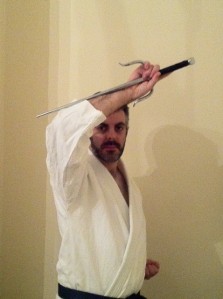In Shotokan circles there has recently been a discussion about the rotation of the hips in the opening movements of Hangetsu. In some quarters it has been suggested that we should no longer rotate the hips, but instead return to a more Okinawan manner of keeping the hips in the front facing “Shomen” position, throughout the technique.
Before I go into the matter of the rotating hips, I think it useful to examine Hangetsu in a broader stylistic context.
Hangetsu (Seisan in other styles) is in any many ways unique amongst the Shotokan library of kata. Hangetsu is one of the few kata that are shared across almost every major style of karate. If there was one kata that typifies karate as a martial art – it would be Hangetsu.
Of course, each style has a slightly different take in the expression of the kata. However, as karateka, this is quite interesting, as it provides an understanding of how the different styles differ from one another. It does not follow that one style has a better version than another, nor than any style has the “original” Hangetsu. Certainly if versions of Hangetsu from Chinese systems are examined, there are similarities to the Okinawan and Japanese versions. But none are identical. If you look at the version(Shisan) from Yong Chun White Crane HERE, you will see what I mean; certainly the stance is almost identical to that found in Shotokan and some Okinawan versions for instance, while the absence of closed fist techniques is an obvious difference.
However, how does the Shotokan Hangetsu compare to that of other karate styles?
The first observation to make is that the Shotokan version is much cleaner, with a smaller variety of techniques. This is in many ways in keeping with the practise of Hangetsu in other styles as a “kihon” kata, in that it is designed to practise fundamental techniques, rather than a kata for beginners. The use of Hangetsu Dachi – is somewhat identical, although how far the lead foot is orientated inwards does differ, as does the length of the stance. Earlier versions of the stance are less inwards orientated.
It does not take much imagination to see how these variations of stance can be used in a free fighting context. Like other styles, Shotokan’s version has grabbing techniques, bearing in mind the variety of other techniques which can be used in conjunction with these grabs; this is again a very practical element of the kata.
The rotation of the hips in the opening reverse punches
Certainly, the Chinese version has no real hip rotation and relies on a square on position. Amongst Okinawan and other Japanese versions however there is a mix of how the hips are used. Some use a rotational hip, will others favour the static shomen position. This suggests to me that adopting a shomen position doesn’t make the kata more or less Okinawan.
What about Shotokan’s historical form – did it rotate or remain static? The problem with this question is that there is no clear answer. Certainly in Wado Ryu, which in terms of kata (see HERE), owes much to the mechanics of the form as originally taught by Funakoshi, the hip is kept in the Shomen position. A second important facet is that the hangetsu stance as performed by Funakoshi is actually much like that of the original Chinese version, shorter, with less inward angles and tension.
It is very likely that the rotating hip is a feature of the kata that was introduced by Nakayama. Although I haven’t come across any explanation as to why the change was made – we can speculate. One benefit of practising the rotation is that it provides the opportunity to develop skill in the so called “hinged hip”, which was promoted by Nakayama. Rather than the hip rotating around a central axis, it moves more like a door hinge where the hip attaches to the leg. Importantly, this prevents the lead leg being pulled backwards when performing gyaku-zuki – in turn it means a more powerful punch. If you watch Osaka in THIS clip you will see it more clearly. The slow motion and mechanics of Hangetsu Dachi greatly facilitate the development of this skill.
The problem with the hinged hip is that it is a comparatively large action, which may not always lend itself to situations where a punch must be made with the smallest possible hip action. For instance, at close quarters, there may be little time to use a full rotation of the hip using this method. In this context the Shomen position makes more sense, as it also facilitates various throwing techniques and conditions the hip in a slightly different way. A second important facet of the shomen position is that it facilitates training of the breath. Although not much found in modern Shotokan, it is however important for developing internal strength.
To rotate or not to rotate?
I see value in both versions, one generates power by co-ordinating breathing with technique, while the other does so through the use of the hinged hip. However, if the Shomen position is adopted then we should also adopt the higher version of the stance as practised by Funakoshi – this way the full benefit of the breath training can be gained. In my personal training I practise both, although I favour the higher stance as practised in China and as taught by Funakoshi regardless of whether I rotate the hip or not.
Further Reading:
Here is a link to an article written by Kousaku Yokota. Although it doesn’t address the issue of hip rotation, it does cover in depth historical issues around breathing and Funakoshi’s Hangetsu-dachi.


